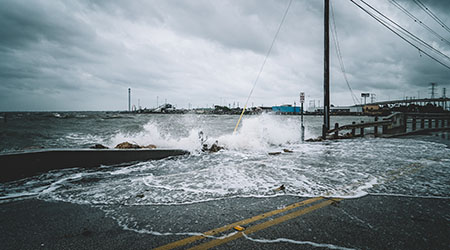We have to be prepared for potential disasters, and that includes preparing for the inevitable financial impact of the situation. Whether a tree falls on your home’s roof during a storm or a healthcare facility is damaged from a hurricane, we normally have insurance to try to make us whole and repair the damage after the fact. But insurance alone does not make us whole.
We typically do not think about an insurance claim until after the event has occurred, and hospitals are no different. The prevailing mindset is to get through the disaster, then figure out filing insurance.
Unfortunately, in the weeks following a disaster, healthcare facilities can lose receipts or take the wrong photos of damage or fail to procure help in the right way. The facility can lose thousands or even millions of dollars in potential insurance claims unless they implement a program that starts the process early in the disaster or even before the disaster strikes.
Managers have better opportunities to prepare a healthcare facility for disaster support and recovery:
Administrative preparation
In known events — where a severe storm or hurricane has been forecast and flooding is inevitable due to heavy rainfall — healthcare facilities managers need to have a plan for tracking the administrative documents they will need for filing insurance. Teams need to be trained for the important work of documenting pre-disaster conditions, as well as preparation costs, damages and supplies purchased post-disaster to recover from the damages.
For unknown events, such as tornadoes, explosions, and flash flooding, tracking expenses early in the process will ensure managers submit every cost associated with the disaster. These tips can help managers track disaster-related costs:
- Create a disaster payroll code so all associates working on a disaster pay schedule can be tracked.
- Create a disaster key word for all expenses related to equipment and supplies purchased specifically in response to or recovering from the disaster.
- Track all travel expenses for team members who travel in support of the disaster.
- Take pictures before the disaster if possible of facility areas prone to damage or flooding from the event. Review hazard vulnerability analysis, flood emergency plans, and sewage emergency plans for vulnerabilities.
- Ensure contractors keep records for all costs, including receipts and tickets for debris removal.
- Educate facilities teams annually on the process and documentation required.
- Record the time of the expense project manager if the organization uses one.
FEMA Public Assistance Program
The Federal Emergency Management Agency (FEMA) can help state, local, tribal, and territorial governments, as well as certain private nonprofit organizations, respond to and recover from major disasters or emergencies. Any costs that private, not-for-profit healthcare systems incur following a disaster that are not covered by insurance can be provided by FEMA’s Public Assistance Program.
Following disasters such as hurricanes, tornados, earthquakes and wildfires, FEMA will reimburse 75-100 percent of systems’ costs for services such as debris removal, overtime pay to workers, procurement of special equipment like chainsaws or generators, and repair to damaged equipment or infrastructure.
If a facility has kept proper documentation as noted above, managers will have greater success in receiving FEMA’s full assistance, as is the case when filing insurance claims. If an organization experiences enough disasters, managers might consider having a full-time project manager to track, coordinate, and file disaster expenses.
FEMA Hazard Mitigation Assistance Grants for facilities that know they are at risk for damage from disasters can provide funding for eligible mitigation measures to reduce disaster losses. When a facility can reduce or eliminate long-term risks to people and property from future disasters, they also can break the cycle of disaster damage, reconstruction, and repeated damage. This long-term solution can benefit the physical facility and the community. Like the Public Assistance Program, FEMA will pay 75 percent of the expenses to mitigate disasters.
For example, FEMA has provided $84 million to a hospital in Florida to mitigate the effects of hurricanes through flood walls and upgraded windows and roofs. This investment not only ensures the facility is available during a disaster. It also protects the facility’s infrastructure, which in turn can help with insurance costs. By reducing risk, managers also can reduce the cost of the policy.
Too many hospitals fail to take advantage of this funding. Some hospitals do not know the program exists. Others think it is too complicated to go through the paperwork and apply, so they do not pursue it. This is a missed opportunity. Managers already should have receipts, photos, and documents from their administrative preparation. Relaying these documents to a grant application, which can be outsourced, is not much more work than facilities already need to do to fully benefit from insurance policies.
Where to start
FEMA’s website has information on the Public Assistance Program and the Hazard Mitigation Assistance Grants to help managers get started. FEMA works with each state’s emergency management agency, so managers also should work with state agencies in pursuing funding. County or city emergency management agencies also might be able to assist in securing funding, so managers should continue to build and cultivate relationships with local agencies to prepare for and mitigate disasters.
As climate change intensifies disasters across the country, it is imperative that healthcare facilities managers be prepared for the worst. Hospitals are vital in times of emergency, and every effort that managers can take to the facilities for disasters to ensure they return to normal operations faster and avoid damage in the first place helps prepare the greater community to deal with emergencies.
Scott Cormier is vice president of emergency management, environment of care and safety with Medxcel, which specializes in facilities management, safety, environment of care, and emergency management and provides healthcare service support products and drives in-house capabilities, saving and efficiencies for healthcare organizations that improve the overall healing environment for patients and staff. Cormier leads the development and implementation of emergency management, general safety, and accident-prevention programs for the national network of hospitals Medxcel serves.

 Should We Be Testing Toilet Water in Patient Restrooms?
Should We Be Testing Toilet Water in Patient Restrooms? Healthcare Union Petitions for Increased Staff Safety at HCA Florida Hospitals
Healthcare Union Petitions for Increased Staff Safety at HCA Florida Hospitals HGA Announces Completion of the Jeffrey and Patricia Cole Pavilion
HGA Announces Completion of the Jeffrey and Patricia Cole Pavilion Healthcare Facilities Look to Future-Proof Facilities
Healthcare Facilities Look to Future-Proof Facilities Yale New Haven Health Experiences Data Breach
Yale New Haven Health Experiences Data Breach